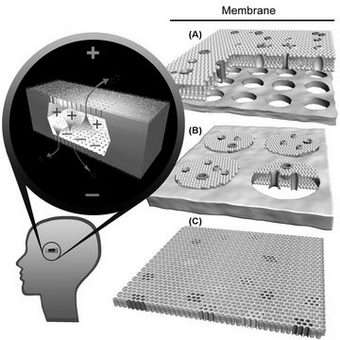Researchers to develop nano-size battery to be implanted in eye to power artificial retina

Several researchers from Sandia National Laboratories, led by principal investigator Susan Rempe, are part of a multi-institutional, multidisciplinary team developing a nano-size battery that one day could be implanted in the eye to power an artificial retina.
They are among the recipients of a five-year, $6.5 million grant recently awarded by the National Eye Institute of the National Institutes of Health (NIH) to establish a new center, the National Center for Design of Biomimetic Nanoconductors. Based at the University of Illinois Urbana-Champaign under the direction of principal investigator Eric Jakobsson, the center is designed to rapidly launch revolutionary ideas in the use of nanomedicine.
The center will design, model, synthesize, and fabricate nanomedical devices based on natural and synthetic ion transporters — proteins that control ion motion across the membranes of every living cell.
The first task for the center will be to design a class of devices for generating electric power — bio-batteries — for a wide array of implantable devices, starting with an artificial retina that has already been developed at the Doheny Eye Institute at the University of Southern California. The artificial retina and accompanying nanobattery will be used to correct certain types of macular degeneration.
Sandia’s role is on the theoretical and computational side of the project, Rempe says. Sandia is a National Nuclear Security Administration laboratory.
“We will use our expertise in multi-scale modeling to understand and predict how transporter structure leads to function, with an initial focus on specialized transporters found in the electric eel,” Rempe says. “This information will give us a better understanding of how power is naturally created in biological organisms — information to be used for designing and building the nanobattery.”
Speaking of the vital role of modeling, she adds, “If you don’t understand it, you can’t engineer it.”
Ultimately the algorithms, software, design expertise, and scientific knowledge gained through the modeling efforts, in which Rempe is joined by Kevin Leung and Steve Plimpton, will be shared with the external community through workshops, seminars, conferences, and collaborations.
Working on another aspect of the project is Jeff Brinker, who is affiliated with both Sandia and the University of New Mexico. He will engineer components of the bio-battery using silica technology.
The team plans to translate several categories of biological function into new devices that would treat disease and lead to implantable devices. Properties of interest that appear in the biological ion transporters include electrical signaling, osmotic pumping, and molecular detection.
Source: Sandia National Laboratories
















